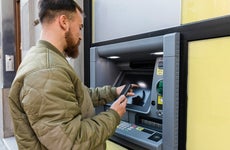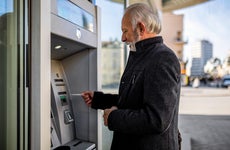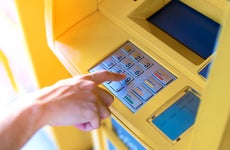How to avoid ATM fees

The Bankrate promise
At Bankrate we strive to help you make smarter financial decisions. While we adhere to strict , this post may contain references to products from our partners. Here's an explanation for .
ATM fees are among several kinds of bank fees that can eat into your account balance over time if you don’t look out for them.
There are two fees that may come with a withdrawal at an ATM that are outside of your bank’s network: a surcharge from the ATM’s owner and an out-of-network fee from your bank or credit union. The average surcharge is $3.15, and the average out-of-network fee is $1.58, according to Bankrate’s 2023 checking account and ATM fee study.
The total cost of making an ATM withdrawal has increased from previous years, and the fees can really add up. They’re avoidable — or at least reducible — though, if you take some simple measures.
Key takeaways
- It pays to avoid out-of-network ATM fees, with the current average total fee having climbed to a record high of $4.73.
- When you need cash, but there's no in-network ATM near you, one option is to get cash back when making a purchase at a grocery store or other retailer.
- Other ways to avoid ATM fees include finding a bank account that reimburses such fees or simply opting for digital payments over cash ones.
Ways to avoid ATM fees
1. Get cash back
When you check out at a grocery store or other retailer, you’ll typically have the option to get cash back with the purchase. To get cash back, pay with a prepaid or debit card, and enter your personal identification number (PIN). The PIN pad will prompt you to either select an amount or enter the amount you’d like in cash back, to be withdrawn from the account associated with the card. Getting cash back from a store generally does not incur any fees.
2. Find in-network ATMs
When you use an out-of-network ATM, you may be hit with a surcharge from the bank that owns the ATM, as well as a fee from your bank for using an ATM not in its network. Sticking to in-network ATMs is a simple way to avoid these costs.
An ATM owned by your bank or credit union, or one that’s within the bank’s partnered ATM network (such as Allpoint or MoneyPass), won’t charge the out-of-network fee. To find an in-network ATM, try using an ATM locator on your bank’s mobile app or its website.
3. Go digital with a payment app
In many cases when you’d normally use cash, it’s possible to go digital instead. This way, you don’t have to withdraw money from an ATM at all. For example, some service providers, such as hairdressers, may accept tips through digital payment providers, such as Venmo or Zelle. Some retailers may also accept payment for goods through these peer-to-peer payment apps. Just make sure to check beforehand that your preferred payment app is accepted by the merchant.
4. Withdraw larger sums, less frequently
It pays to make fewer withdrawals from out-of-network ATMs, since each withdrawal will likely come with a fee. You can take out larger sums of cash in a single ATM visit to prepare for cash spending in advance.
Keep in mind that there are ATM withdrawal limits, however. The maximum amount you can withdraw from an ATM varies by bank and ATM, but it typically ranges from $500 to $1,000 a day.
5. Open an account that reimburses fees
There are numerous banks and credit unions that offer checking accounts with no ATM fees or reimbursements for ATM fees. Many of these are online-only banks.
Some financial institutions will reimburse fees up to a certain amount each month, such as Alliant Credit Union, which reimburses up to $20 a month in ATM fees for Alliant Visa debit card users. The credit union states that reimbursements are deposited into the customer’s account at the end of the day.
Other banks may even offer unlimited ATM reimbursements. Axos Bank, for example, offers unlimited domestic ATM reimbursements for Axos Rewards Checking account owners. LendingClub also reimburses all ATM surcharges for its checking account by crediting them back to customers at the end of each statement cycle.
How to find an ATM without fees
You can usually locate nearby ATMs owned by your bank — or ones in its fee-free network — by checking your bank’s app or website. Most banks offer an ATM locator tool that shows you nearby ATMs on a map.
If you’re a regular ATM user who’s shopping around for a new bank, be sure to go with one that offers plentiful ATMs, whether the bank owns the ATMs or partners with an ATM network such as MoneyPass or Allpoint. Alternatively, you can go with a bank that doesn’t charge out-of-network ATM fees and also reimburses ATM surcharges imposed by other banks.
Using ATMs that don’t charge fees is always a good idea, since these charges can really add up — in some cities more than others. For instance, cities with the highest ATM fees include Atlanta, Phoenix and Detroit. Conversely, metro areas with the lowest ATM fees include Seattle, Philadelphia and Boston, Bankrate’s 2023 checking and ATM survey found.
Bottom line
Getting money from an out-of-network ATM and paying the average total ATM withdrawal fees just twice a month would cost you $113.52 in fees in one year. But doing something as simple as looking up what ATMs are in your bank or credit union’s network could help save on fees.
There’s no single way to minimize ATM fees, but there are several strategies depending on how you prefer to bank and what you need cash for. When possible, going digital by using a payment app can save a trip to the ATM and several bucks in fees. Also, check with your bank to see if it already offers reimbursements for ATM fees.
— Bankrate’s Karen Bennett contributed to an update of this story.
Related Articles



